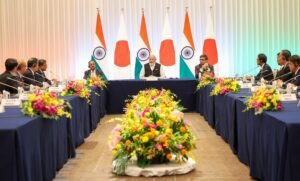New Delhi (Defence Correspondent): It is beyond any scope for a second thought that the Indian Army is one of the most powerful combat force in the world be it by the magnanimous size of it or in terms of advanced technologies it owns.
At the same time, if we look around the current situation around the world, conflicts are rising day by day engaging new countries every time. With such happenings, India too remains concerned and at the same time vigilant on its borders.
But to talk about India, we need to understand its border concerns that very evidently are at the Sino-India (India – China) border and the Indo-Pak (India – Pakistan) border. While India shares its northern and eastern borders with China, it is the western border where it touches the boundary of Pakistan.
With both China and Pakistan, India has not had a long standing friendly relations and with both countries regular clashes and tussles have been an ongoing issue at the borders.
But if in case any such tussle escalates to another war, is India doing enough to handle it efficiently?
India – Pakistan
Stretching over 3000 kilometres, the India-Pakistan border, has been a highly sensitive and militarized boundary sine division of the two countries. By the Indian government, the border has been divided into four segments — the Line of Control (LoC) in Jammu and Kashmir, the International Border (IB), the Actual Ground Position Line (AGPL) in Siachen, and the Working Boundary near Jammu.
Given regular Pak sponsored terror attacks on the Indian soil Indian army has always ensured stricter security measures that include fences, surveillance systems, and a strong military presence.
From a range of artillery systems to air defence systems and latest missile systems like anti-tank guided missiles, ballistic and cruise missiles, to advanced radars, India’s western border has a robust system in place for any contingency.
Other than these, we have marine vessels as well as aircraft like helicopters, unmanned aerial vehicles, and loitering munitions that can be scrambled in no time when needed.
Not only India has armoured combat vehicles but also sufficient utility and staff transport, goods and field transport vehicles, engineering and support vehicles, and unmanned ground vehicles
It is also important to have a string system in place as the Western Command of the Indian Army is responsible for the states of Punjab, Haryana, Delhi, and parts of Jammu.
India – China
At the same time, when we talk of India’s border with China and India’s preparedness at this front, the Indian Army is highly equipped to deal with any possible challenge making its way into India from China.
The international boundary between India and China stretches over 3400 kilometres and is referred to as the Line of Actual Control (LAC).
The Indian Army has deployed sufficient troops at dominant positions along the LAC including positions over Pangong Tso and positions dominating the Demchok and Chumar sectors.
These troops are equipped with advanced weaponry and technology, including anti-aircraft guns, upgraded legacy guns, the Ultra Light Howitzer M-777, and automated artillery systems like Bofors guns.
Other than latest warfare systems, the Indian Army also uses drones, thermal imaging systems, and satellite imagery to maintain real-time intelligence on movement along the LAC.
Not only this by the Indian Army also keep updating its military infrastructure along the Line of Actual Control (LAC). These may include building roads and timely ammunition dumps.
In order to keep its men prepared round the clock, the soldiers, specially those deployed at the LAC, undergo months of training to acclimatize to the altitude and extreme cold. They not only learn high-altitude warfare tactics and rapid movement across mountains but also adapt survival exercises in sub-zero temperatures.
It is a fact that India’s military is the world’s second-largest military force, with over 1.4 million active personnel. It also has the third-largest defence budget in the world. But despite that the country has lost many of its men that go war with China and Pakistan on regular basis following disputes and clashes on the border.
These are challenges that not only remain restricted to borders but also affect a country’s growth. India, therefore, as it rises as one of the world powers, while at one hand remains vigilant and dominating at its northern and western fronts, on the other it indulges in practices endorsing world peace underlining its belief of ‘Vasudev Kutumbakam’ – ‘World is a Family’.









